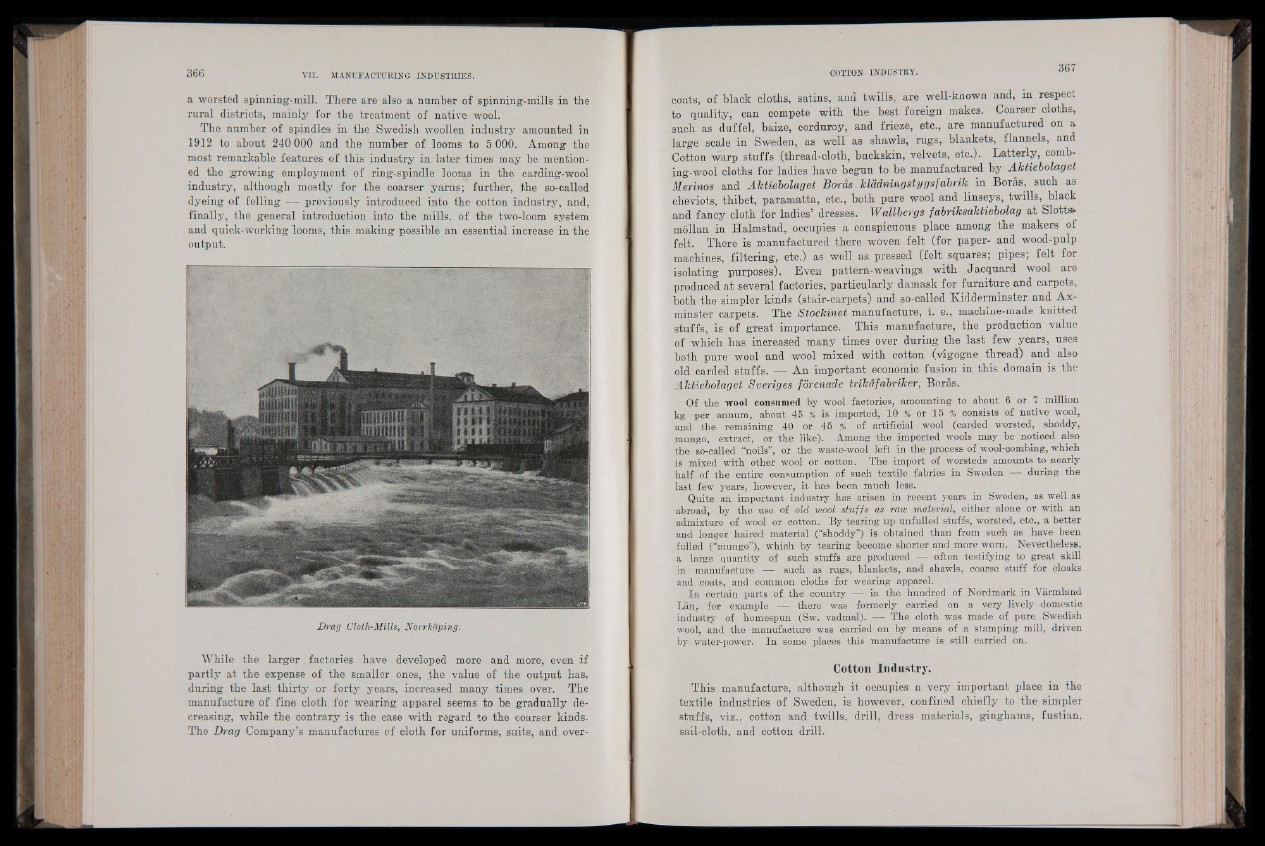
a worsted spinning-mill. There are also a number of spinning-mills in the
rural districts, mainly for the treatment of native wool.
The number of spindles in the Swedish woollen industry amounted in
1912 to about 240 000 and the number of looms to 5 000. Among the
most remarkable features of this industry in later times may be mentioned
the growing employment of ring-spindle looms in the carding-wool
industry, although mostly for the coarser yarns; further, the so-called
dyeing of felling — previously introduced into the cotton industry, and,
finally, the general introduction into the mills, of the two-loom system
and quick-working looms, this making possible an essential increase in the
output.
Drag Cloth-Mills, Norrhoping.
While the larger factories have developed more and more, even if
partly at the expense of the smaller ones, the value of the output has,
during the last thirty or forty years, increased many times over. The
manufacture of fine cloth for wearing apparel seems to be gradually decreasing,
while the contrary is the case with regard to the coarser kinds.
The Drag Company’s manufactures of cloth for uniforms, suits, and overcoats,
of black cloths, satins, and twills, are well-known and, in respect
to quality, can compete with the best foreign makes. Coarser cloths,
such as duffel, baize, corduroy, and frieze, etc., are manufactured on a
large scale in Sweden, as well as shawls, rugs, blankets, flannels, and
Cotton warp stuffs (thread-cloth, buckskin, velvets, etc.). Latterly, comb-
ing-wool cloths for ladies have begun to be manufactured by Ahtiebolaget
Merinos and Alctiebolaget Boras kladningstygsfabrik in Boras, such as
cheviots, thibet, paramatta, etc., both pure wool and linseys, twills, black
and fancy cloth for ladies’ dresses. Wallbergs fabriksaktiebolag at Slotta*
mollan in Halmstad, occupies a conspicuous place among the makers of
felt. There is manufactured there woven felt (for paper- and wood-pulp
machines, filtering, etc.) as well as pressed (felt squares; pipes; felt for
isolating purposes). Even pattern-weavings with Jacquard wool are
produced at several factories, particularly damask for furniture and carpets,
both the simpler kinds (stair-carpets) and so-called Kidderminster and Ax-
minster carpets. The Stockinet manufacture, i. e., machine-made knitted
stuffs, is of great importance. This manufacture, the production value
of which has increased many times over during the last few years, uses
both pure wool and wool mixed with cotton (vigogne thread) and also
old carded stliffs. — An important economic fusion in this domain is the
Ahtiebolaget Sveriges fôrenade trikafabriher, Boras.
Of the wool consumed by wool factories, amounting to about 6 or 7 million
kg per . annum, about 45 % is imported, 10 % or 15 % consists of native wool,
and the remaining 40 or 45 % of artificial wool (carded worsted, shoddy,
mungo, extract, or the like). Among the imported wools may be noticed also
the so-called “noils”, or the waste-wool left in the process of wool-combing, which
is mixed with other wool or cotton. The import of worsteds amounts to nearly
half of thé entire consumption of such textile fabrics in Sweden — during the
last few years, however, it has been much less.
Quite, an important industry has arisen in recent years in Sweden, as well as
abroad, -by the use of old wool stuffs as raw material, either alone or with an
admixture of wool or cotton. By tearing up unfulled stuffs, worsted, etc., a better
and longer haired material (“shoddy”) is obtained than from such as have been
fulled (“mungo”), which by tearing become shorter and more worn. Nevertheless,
a large quantity of such stuffs are produced IJfgoften testifying to great skill
in manufacture — such as rugs, blankets, and shawls, coarse stuff for cloaks
and coats, and common cloths for wearing apparel.
J-n- certain parts of the . country i f in the hundred of Nordmark in Varmland
Lan, for example — there was formerly carried on a very lively domestic
industry of homespun (Sw. vadmal). S - The cloth was made of pure Swedish
wool, and the manufacture was carried on by means of a stamping mill, driven
by water-power. In some places this manufacture is still carried on.
Cotton Industry.
This manufacture, although it occupies a very important place in the
textile industries of Sweden, is however, confined chiefly to the simpler
stuffs, viz., cotton and twills, drill, dress materials, ginghams, fustian,
sail-cloth, and cotton drill.